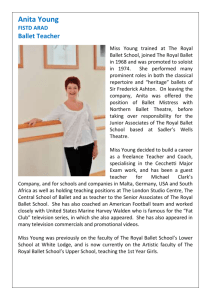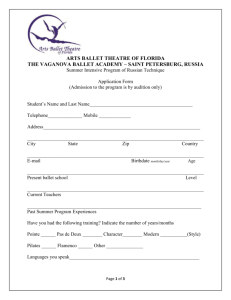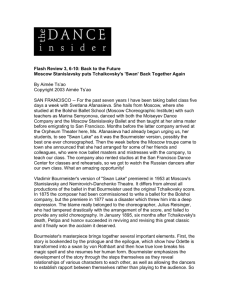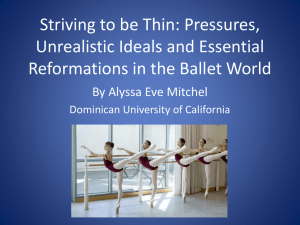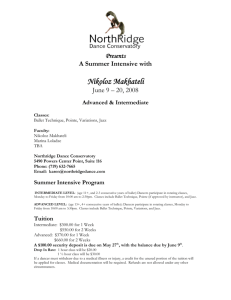3100 HERBST HUMANITIES FOR ENGINEERS
advertisement
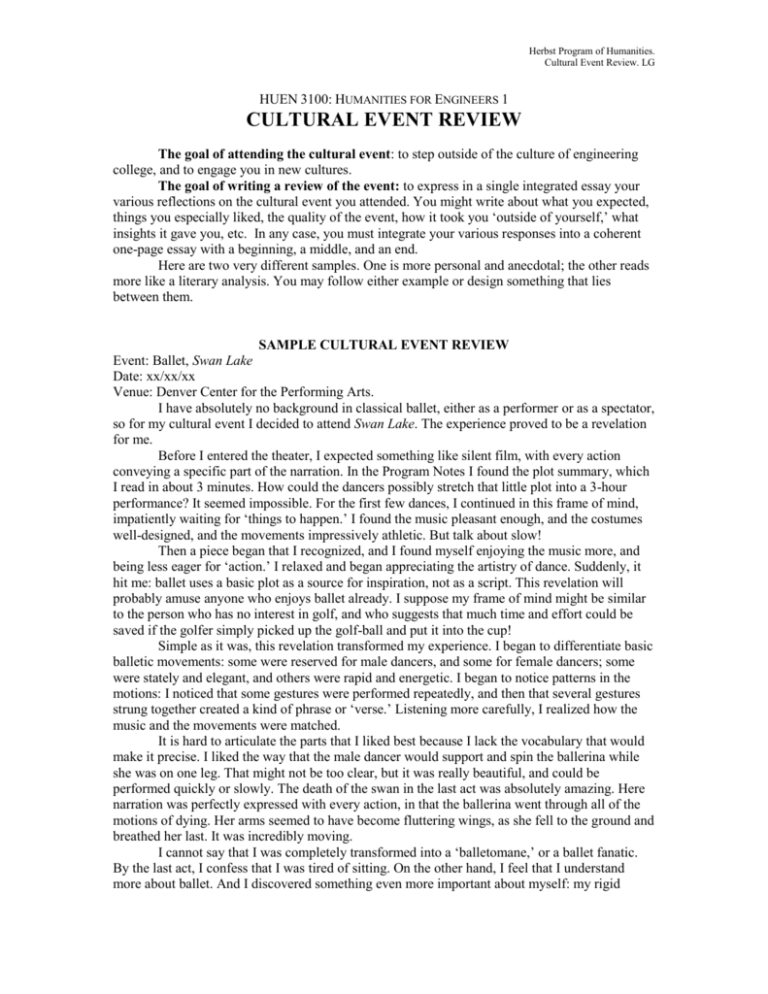
Herbst Program of Humanities. Cultural Event Review. LG HUEN 3100: HUMANITIES FOR ENGINEERS 1 CULTURAL EVENT REVIEW The goal of attending the cultural event: to step outside of the culture of engineering college, and to engage you in new cultures. The goal of writing a review of the event: to express in a single integrated essay your various reflections on the cultural event you attended. You might write about what you expected, things you especially liked, the quality of the event, how it took you ‘outside of yourself,’ what insights it gave you, etc. In any case, you must integrate your various responses into a coherent one-page essay with a beginning, a middle, and an end. Here are two very different samples. One is more personal and anecdotal; the other reads more like a literary analysis. You may follow either example or design something that lies between them. SAMPLE CULTURAL EVENT REVIEW Event: Ballet, Swan Lake Date: xx/xx/xx Venue: Denver Center for the Performing Arts. I have absolutely no background in classical ballet, either as a performer or as a spectator, so for my cultural event I decided to attend Swan Lake. The experience proved to be a revelation for me. Before I entered the theater, I expected something like silent film, with every action conveying a specific part of the narration. In the Program Notes I found the plot summary, which I read in about 3 minutes. How could the dancers possibly stretch that little plot into a 3-hour performance? It seemed impossible. For the first few dances, I continued in this frame of mind, impatiently waiting for ‘things to happen.’ I found the music pleasant enough, and the costumes well-designed, and the movements impressively athletic. But talk about slow! Then a piece began that I recognized, and I found myself enjoying the music more, and being less eager for ‘action.’ I relaxed and began appreciating the artistry of dance. Suddenly, it hit me: ballet uses a basic plot as a source for inspiration, not as a script. This revelation will probably amuse anyone who enjoys ballet already. I suppose my frame of mind might be similar to the person who has no interest in golf, and who suggests that much time and effort could be saved if the golfer simply picked up the golf-ball and put it into the cup! Simple as it was, this revelation transformed my experience. I began to differentiate basic balletic movements: some were reserved for male dancers, and some for female dancers; some were stately and elegant, and others were rapid and energetic. I began to notice patterns in the motions: I noticed that some gestures were performed repeatedly, and then that several gestures strung together created a kind of phrase or ‘verse.’ Listening more carefully, I realized how the music and the movements were matched. It is hard to articulate the parts that I liked best because I lack the vocabulary that would make it precise. I liked the way that the male dancer would support and spin the ballerina while she was on one leg. That might not be too clear, but it was really beautiful, and could be performed quickly or slowly. The death of the swan in the last act was absolutely amazing. Here narration was perfectly expressed with every action, in that the ballerina went through all of the motions of dying. Her arms seemed to have become fluttering wings, as she fell to the ground and breathed her last. It was incredibly moving. I cannot say that I was completely transformed into a ‘balletomane,’ or a ballet fanatic. By the last act, I confess that I was tired of sitting. On the other hand, I feel that I understand more about ballet. And I discovered something even more important about myself: my rigid Herbst Program of Humanities. Cultural Event Review. LG expectations had interfered with my appreciation. Once I set them aside, and took the performance on its own terms, it became really interesting, and I began to enjoy it. Considering both art appreciation and self-discovery, I would say that this was a very successful assignment! SAMPLE CULTURAL EVENT REVIEW Event: Foreign Film, La Grande Illusion, directed by Jean Renoir (1937), in French Date: xx/xx/xx Venue: My house. Many prisoner-of-war films emphasize the misery of prison life and the brutality of the guards. In Jean Renoir’s La Grande Illusion, however, the World War I prisoners encounter respect, kindness, and even understanding. The mood is established within minutes of the film’s beginning, with the captured Frenchmen Boldieu and Maréchal joining a German dinner-party hosted by von Rauffentstein, their enemy. All is gracious hospitality and cordiality here because Baron von Rauffenstein has welcomed Count Boldieu. A bond transcending any national ties unites the two aristocrats: they have shared cosmopolitan society, cultural refinements, military service, equestrian excellence—and even, apparently, the same lovely lady in Paris. Yet Rauffenstein alone does not account for this spirit of human solidarity in the film. Repeatedly, ordinary Germans soldiers offer friendship, consolation, and kindness to their French prisoners. Arthur always treats Boldieu and his men well, and regularly offers them a fond goodnight. Maréchal’s guard strives to help him survive the monotony of solitary confinement. Maréchal pines to hear “someone speak French,” but the German guard, not speaking that language, can only offer cigarettes and a harmonica. The guard nevertheless understands his prisoner perfectly: “the war is lasting too long.” This view unites all of the characters in the film. Opposing this universal human fellowship, strong nationalistic feelings emerge. The tennis-playing British officer is no more than a comic stereotype, but the Russians represent a potent nationalism as they mutter resentfully against their Czar’s ill-chosen gift of books; a few years later, after all, their resentment will lead to the Russian Revolution. The solidarity of allied forces erupts in the spontaneous singing of La Marseillaise that breaks up the prisoners’ stageplay; British and French soldiers alike doff their hats and wigs for that ballad of freedom. The most unexpected form of nationalistic spirit, though, comes from the aristocrat, Count Boldieu, who sacrifices himself for the sake of his French compatriots—even though one is a garage mechanic and the other a nouveau-riche. The very unexpectedness of Boldieu’s new national allegiance enables him to fool von Rauffenstein and to help Maréchal and Rosenthal to escape. The case of Boldieu reveals that the real drama here is not prison-camp life, but rather the passing of the old society and the birth of a new one. Count Boldieu casts in his lot with his fellow-Frenchmen because he recognizes that the old society is doomed. Baron von Rauffenstein, on the other hand, clings to the old society. Patched together with metal plates and withdrawn from active service, the Baron represents the moribund cosmopolitan aristocracy: his physical rigidity underscores his inflexibility with respect to the changing world. His old-world dignity still charms us, as he commemorates the Count’s death with the only flower in the castle. We can sense that the dying aristocracy will take away much of the world’s beauty as it gives way to a more egalitarian society. Director Jean Renoir has transcended the categories of ‘our side’ and ‘their side,’ not only with respect to armies, but also with respect to class. Without passing judgment, he has recorded the decline of the aristocracy as an inevitable concomitant of the rise of democratic nationalism.




